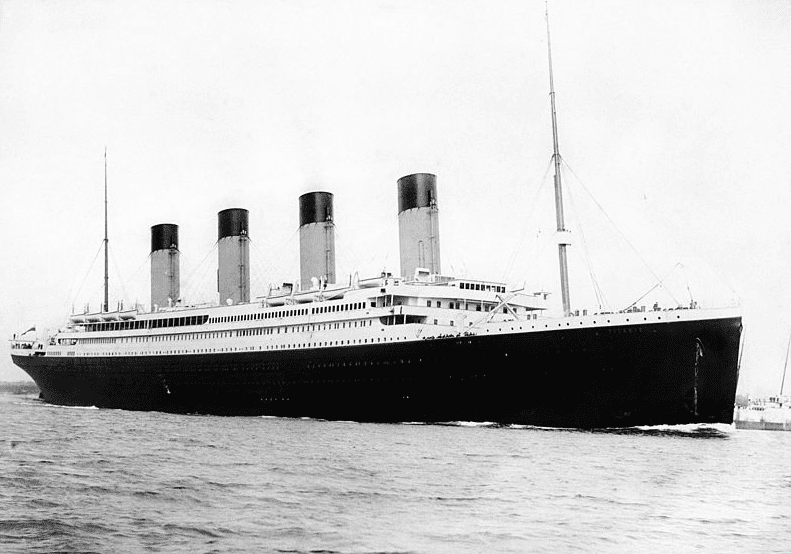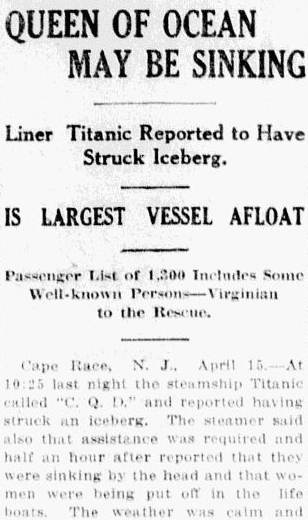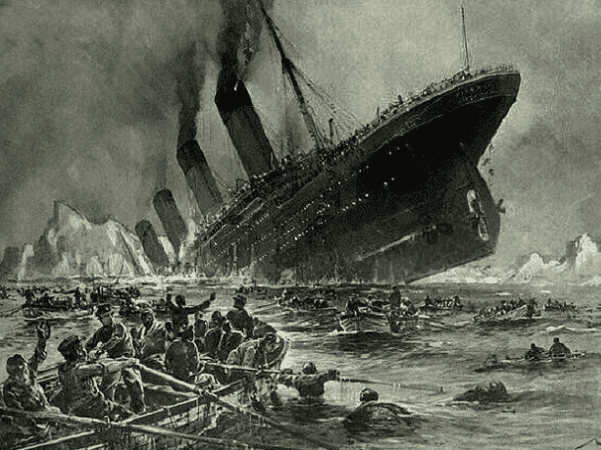Introduction: In this article, Gena Philibert-Ortega searches old newspapers to find out more about the tragedy of the sinking of the Titanic—and shows how helpful those articles can be with your own family history research. Gena is a genealogist and author of the book “From the Family Kitchen.”
The Titanic was fast sinking. After she went down the cries were horrible. This was at 2:20 a.m. by a man’s watch who stood next to me. At this time three other boats and ours kept together by being tied to each other. The cries continued to come over the water. Some of the women implored Officer Lowe, of No.14, to divide his passengers among the three other boats and go back to rescue. His first answer to those requests was, “You ought to be damn glad you are here and have got your own life.” —Affidavit of Titanic first-class passenger Daisy Minahan*

Quite often, in the frantic rush to get the story of a disaster out to the public, the initial news reports are not correct. Today we know only too well what happened on that frigidly cold night in April 1912 when the Titanic hit an iceberg and subsequently sank. At the beginning of its doomed voyage on April 10th there were 2,224 passengers and crew aboard the Titanic when it sailed from England, but in the earliest hours of April 15th there were only 700 survivors.**
Early Survivor Reports in the Newspapers
Few details about the Titanic sinking existed for the newspapers to report on the morning of April 15th. In an era before more modern technologies, the wireless and its brief messages via Morse code were all that the newspapers had to go on. In this example from a South Carolina newspaper, the first paragraph reports that the Titanic sent out a distress call reporting they were sinking and “women were being put off in the life boats.”
Readers may notice that this news article reports the distress call Titanic sent out was “CQD,” not the more familiar “SOS.” CQD was a distress call used prior to SOS that indicated “All Stations Distress.” Although this newspaper article indicated CQD was sent out by the Titanic wireless operators, they actually used both distress signals in their radio pleas for help.***

Some of these very early newspaper reports about the sinking of the Titanic had few correct facts. In this example from a California newspaper, not only does the article report that all Titanic passengers are safe—it says that the “Disabled Ship Is Proceeding under Own Steam.”
As time went on, first-hand accounts of Titanic survivors who were rescued by the steamship Carpathia began to appear in the newspapers. These published Titanic survivor stories were important in helping the public on both sides of the ocean better understand the tragedy. For example, in this article from a Pennsylvania newspaper, an unnamed Carpathia passenger tells of witnessing the Titanic lifeboats approach the Carpathia. Describing the survivors as they came aboard the rescue ship, this witness stated:
There were husbands without wives, wives without husbands, parents without children and children without parents. But there was no demonstration. No sobs, scarcely a spoken word. They seemed to be stunned.
Titanic Survivors List of Passengers & Crew
Little by little, lists of names of those rescued Titanic passengers and those who had perished were printed in the newspapers. This list from a North Dakota newspaper shows the third-class passengers rescued and taken aboard the Carpathia.
For those awaiting news of loved ones, these piecemeal Titanic survivor lists that appeared must have made the pain unbearable – unless your family member or friend’s name appeared on one of the early lists, in which case the relief was surely overwhelming. This next list is of surviving first- and second-class passengers “as received by wireless at Cape Race,” Newfoundland, Canada.
Here is a transcription of this list, alphabetized, with corrections.
| Abbott, Rosa | Allen, Miss E. W. | Anderson, Harry |
| Appleton, C. | Astor, Mrs. John Jacob | Barkworth, A. H. |
| Baxter, Mrs. James | Brayton, George A. | Beckwith, Mr. and Mrs. R. L. |
| Behr, Karl H. | Bishop, Mr. and Mrs. D. H. | Bjornstrom-Steffansson, M. H. |
| Blank, Henry | Bonnell, Miss Caroline | Bowen, Miss G. S. |
| Bowerman, Miss Elsie | Brown, Mrs. J. J. | Brown, Mrs. J. M. |
| Calderhead, E. P. | Candee, Mrs. Churchill | Cardeza, Mrs. J. W. |
| Cardeza, Thomas | Carter, Miss Lucile | Carter, Master William |
| Carter, Mr. and Mrs. William E. | Cavendish, Mrs. Julia Florence | Chaffee, Mrs. C. C. |
| Chambers, Mr. and Mrs. N. C. | Chaudanson, Miss Victorine | Cherry, Miss Gladys |
| Chevre, Paul | Clark, Mrs. Walter | Cornell, Mrs. R. C. |
| Crosby, Miss Harriette | Cumings, Mrs. John B. | Daniel, R. W. |
| Davidson, Mrs. Thornton | Dick, Mr. and Mrs. A. A. | Dodge, Master Washington |
| Dodge, Dr. and Mrs. Washington | Douglas, Mrs. Fred C. | Douglas, Mrs. Walter |
| Duff-Gordon, Sir and Lady Cosmo | Flynn, J. I. | Fortune, Miss Alice |
| Fortune, Miss Ethel | Fortune, Miss Mabel | Fortune, Mrs. Mark |
| Frauenthal, Dr. and Mrs. Henry | Frauenthal, Dr. I. G. | Frolicher, Miss Margaritha |
| Futrelle, Mrs. Jacques | Gibson, Miss Dorothy | Gibson, Mrs. Leonard |
| Goldenberg, Mr. and Mrs. Samuel | Gracie, Colonel Archibald | Graham, Miss Margaret E. |
| Graham, Mrs. William | Greenfield, Mrs. Leo D. | Greenfield, William B. |
| Harder, Mrs. and Mrs. Geo. A. | Harper, Mr. and Mrs. Henry S. | Harris, Mrs. Henry B. |
| Hawksford, Walter | Hays, Mrs. Charles M. | Hays, Miss Margaret |
| Hippach, Miss Gertrude | Hippach, Mrs. Ida S. | Hogeboom, Mrs. John C. |
| Hoyt, Mr. and Mrs. Fred M. | Ismay, J. Bruce | Leader, Mrs. J. A. |
| Lines, Mrs. Ernest | Lines, Miss Mary C. | Longley, Miss G. F. |
| Madill, Miss Georgette A. | Maioni, Miss Roberta | Marechal, Pierre |
| Marvin, Mrs. D. W. | Mayne, B. A. | McGough, James |
| Minahan, Miss Ida Daisy | Minahan, Mrs. W. E. | Mock, Philipp E. |
| Newell, Miss Madeleine | Newell, Miss Marjorie | Newsom, Miss Helen |
| Oliva y Ocana, Dona Fermina | Omont, Alfred F. | Ostby, Miss Helen R. |
| Peuchen, Major Arthur | Potter, Mrs. Thomas | Rheims, George |
| Robert, Mrs. Edward S. | Romaine, Charles | Rosenbaum, Miss Edith |
| Rothes, Countess of | Rothschild, Mrs. Martin | Ryerson, Master John |
| Saalfeld, Adolphe | Salomon, Abraham | Schabert, Mrs. Paul |
| Serreplaa, Miss Augusta | Seward, Frederic | Silverthorne, Spencer Victor |
| Silvey, Mrs. William B. | Simonius-Blumer, Colonel Alfons | Sloper, William T. |
| Smith, Mrs. Lucian P. | Snyder, Mr. and Mrs. John | Spedden, Mr. and Mrs. F. O. |
| Spedden, Master Robert Douglass | Spencer, Mrs. W. A. | Stahelin-Maeglin, Dr. Max |
| Stengel, Mr. and Mrs. C. E. H. | Stephenson, Mrs. Walter B. | Stone, Mrs. George N. |
| Swift, Mrs. Frederick Joel | Taussig, Mrs. Emil T. | Taussig, Miss Ruth |
| Taylor, Mr. and Mrs. E. Z. | Thayer, Mr. and Mrs. J. B. | Thorne, Miss Gertrude M. |
| Tucker, Gilbert M. | Warren, Mrs. F. M. | White, Mrs. J. Stuart |
| Wick, Mrs. George D. | Wick, Miss Mary | Widener, Mrs. George D. |
| Willard, Miss Constance | Woolner, Hugh | Young, Miss Marie |
Because these lists of names from the Titanic were printed as soon as they were acquired, mistakes were made and later corrections had to be published. In this Titanic victims list from the ship MacKay Bennett, names of shipwreck victims according to their “class” are accounted. Those deceased passengers whose names were previously misspelled are now corrected.
This California newspaper article names 27 bodies that were recovered from the icy waters of the North Atlantic. In some cases the names didn’t appear on the passenger list, so it was assumed they were the bodies of Titanic crew members. Obviously, identifying all of the shipwreck victims was not easy since many of them were “clad only in sleeping garments.”
What happened to the victims of the Titanic? The steamship MacKay Bennett, charted by the White Star Line, recovered over 300 bodies. Some bodies were placed in coffins and transported back to Halifax where they were either released to family for burial, or buried in three Titanic cemeteries in Halifax. Those that were too damaged or decomposed were reburied at sea.****
While some may believe that the Titanic’s 700 survivors were lucky, not all went on to live happily ever after. Daisy Minahan, whose testimony was shared above, was admitted to a sanitarium for pneumonia shortly after the disaster and then died of tuberculosis seven years later at the young age of 40.*****
Eight former Titanic passengers committed suicide later in their lives. One of the Titanic crew, Violet Jessop, survived the Titanic sinking and then survived the sinking of her sister ship, the HMHS Britannic, four years later.
Thankfully, after the sinking of the Titanic inquiries in England and the United States resulted in additional passenger ship safety measures such as lifeboat drills and the inclusion of enough lifeboats for all passengers, iceberg monitoring, and changes to ship design. While too late for those who lost their lives on the once-deemed unsinkable ship, it did help prevent tragedies of the same magnitude.
Please share in the comments section any Titanic stories you’ve run across in your own family history research.
Related Titanic articles:
- Amazing Survival Stories of Last Moments on the Titanic
- Eating on the Titanic: Massive Quantities of Food on the Menu
- Elizabeth Gladys Dean (1912-2009) Last Titanic Survivor Dies
_____________________
* United States Inquiry Day 16. Affidavit of Daisy Minahan. Titanic Inquiry Project. Accessed 4 April 2014 .
** About RMS Titanic. Encyclopedia Titanica. Accessed 4 April 2014.
*** Rescue at Sea. CQD and SOS. American Experience. Accessed 4 April 2014 http://www.pbs.org/wgbh/amex/rescue/peopleevents/pandeAMEX88.html.
**** Titanic victims buried at sea shown in unique photograph by Philip Hind. Encyclopedia Titanic. Accessed 4 April 2014.
***** Miss Daisy E. Minahan. Encyclopedia Titanica. Accessed 4 April 2014.
